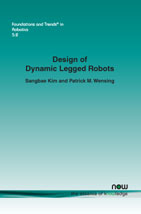Design of Dynamic Legged Robots
By Sangbae Kim, Massachusetts Institute of Technology, USA, sangbae@mit.edu | Patrick M. Wensing, Massachusetts Institute of Technology, USA, pwensing@mit.edu
Abstract
Animals exhibit remarkable locomotion capabilities across land, sea, and air in every corner of the world. On land, legged morphologies have evolved to manifest magnificent mobility over a wide range of surfaces. From the ability to use footholds for navigating a challenging mountain pass, to the capacity for running on a sandy beach, the adaptability afforded through legs motivates their prominence as the biologically preferred method of ground transportation. Inspired by these achievements in nature, robotics engineers have strived for decades to achieve similar dynamic locomotion capabilities in legged machines. Learning from animals’ compliant structures and ways of utilizing them, engineers developed numerous novel mechanisms that allow for more dynamic, more efficient legged systems. These newly emerging robotic systems possess distinguishing mechanical characteristics in contrast to manufacturing robots in factories and pave the way for a new era of mobile robots to serve our society. Realizing the full capabilities of these new legged robots is a multi-factorial research problem, requiring coordinated advances in design, control, perception, state estimation, navigation and other areas. This review article concentrates particularly on the mechanical design of legged robots, with the aim to inform both future advances in novel mechanisms as well as the coupled problems described above. Essential technological components considered in mechanical design are discussed through historical review. Emerging design paradigms are then presented, followed by perspectives on their future applications.
Design of Dynamic Legged Robots
Inspired by the remarkable locomotion capabilities illustrated by animals across land, sea and air, robotics engineers have strived for decades to achieve similar dynamic locomotion capabilities in legged machines. Learning from animals’ compliant structures and ways of utilizing them, engineers have developed numerous novel mechanisms that allow for more dynamic, more efficient legged systems. These newly emerging robotic systems possess distinguishing mechanical characteristics in contrast to manufacturing robots in factories and pave the way for a new era of mobile robots to serve our society. Realizing the full capabilities of these new legged robots is a multi-factorial research problem, requiring coordinated advances in design, control, perception, state estimation, navigation and other areas.
Design of Dynamic Legged Robots focuses on the mechanical design of legged robots. It introduces the topic by looking at the history of legged robots, taking us up to the dynamic legged machines that are today pushing the boundaries of speed and performance through advances in materials, design, and control. It goes on to discuss some of the main challenges to actuator design in legged robots and discusses a recently developed technology called proprioceptive actuators in order to meet the needs of today’s legged machines. It proceeds to discuss philosophical perspectives on designing for energetic efficiency, a critical aspect of legged robot design. The penultimate chapter discusses trends in leg design and presents a case study using principles from observations in biology to design a leg for the MIT Cheetah robot, and concludes with a summary of future directions and applications.
